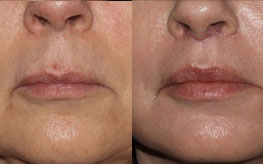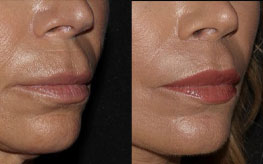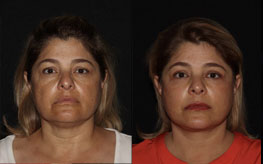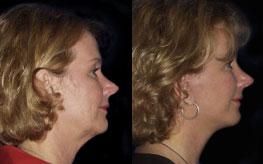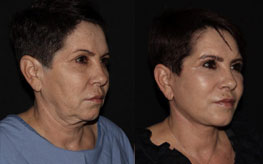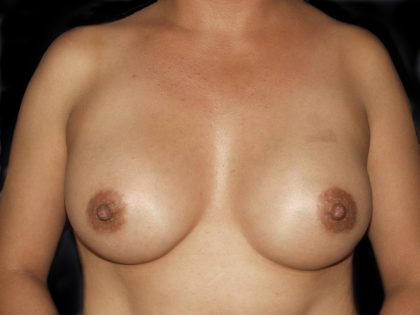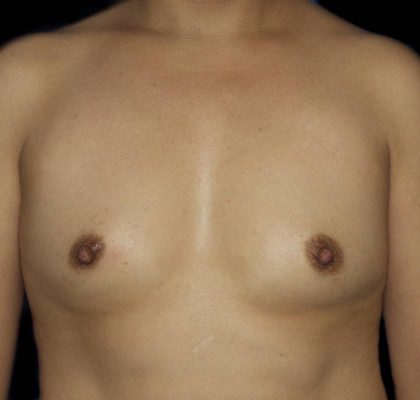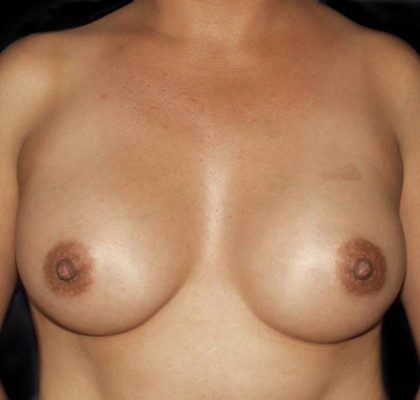Breast Augmentation
Conveniently located to serve the areas of San Diego, CA

Breast Augmentation (Enlargement) is an excellent way to accentuate your curves and restore balance to the body. Women with small breasts, disproportionately sized breasts, or diminished breast volume can all enhance the symmetry, firmness, and size of their breasts through Breast Augmentation.
For more information about your breast augmentation procedure, please contact us online or call us at 888-463-9532. We look forward to helping you look your best.
Contents
Before and After Photos
Understanding the Breast Augmentation Procedure
Also known as augmentation mammaplasty, breast augmentation uses breast implants to create fuller breasts (breast enlargement) or to restore breast volume lost after weight reduction or pregnancy (breast enhancement).
Most women seeking information regarding breast implants fall into two categories: Women with small breasts who have not had children and women who have had children or have lost weight, resulting in smaller breasts
Incision
Incisions are made in inconspicuous areas to minimize visible scarring. We will discuss with you which incision options are best for your desired outcome. There are four possible options for incision placement:
Inframammary incision: in the crease under the breast
Periareolar incision: around the bottom of the areola
Transaxillary incision: under the arm
Transumbilical incision: in the belly button
Incisions vary based on the type of implant, degree of enlargement desired, your particular anatomy, and patient-surgeon preference. In most patients we tend to prefer a periareolar incision because it heals incredible well and can be used again in the future, if necessary, without creating additional scarring. If you are having a breast lift in addition to your breast augmentation, the incision for the lift will be used to insert the breast implants
Type of Implant
There are two types of implants, saline and silicone. The outer covering (shell) of both implants is made of silicone.

Saline breast implants are filled with sterile salt water. The implants come empty and are filled during surgery. They can be filled with varying amounts, which can affect the shape, firmness and feel of the breast. Should the implant shell leak, a saline breast implant will collapse and the saline will be absorbed naturally by the body. Currently Saline breast implants are FDA-approved for augmentation in women 18 years of age and older.
Silicone breast implants are filled with an elastic gel and our pre-filled by the manufacturer. The gel feels and moves much like natural breast tissue. If the implant leaks, the gel may remain within the implant shell, or may leak into the breast implant pocket, but will be contained by the scar tissue capsule, which forms around every implant. A leaking implant filled with silicone gel does not collapse. If you choose these implants, you may need to visit your plastic surgeon regularly to make sure the implants are intact. An ultrasound or MRI screening can assess the condition of breast implants. Currently Silicone breast implants are FDA-approved for augmentation in women 22 years of age and older. Silicone implants may be recommended at a younger age if used for reconstruction purposes. Silicone Gummy-bear implants have a cohesive silicone gel inside that is more solid. These implants are currently being studied and will not readily available until approved by the FDA. They are more commonly used in reconstruction cases for breast cancer.
Position of Implant
Implants can be placed above the pectoralis muscle or below the muscle. Most often, implants are placed below the muscle to obtain better soft tissue coverage of the implant in the medial upper chest. Implants are placed above the muscle when the patient has more breast tissue coverage or when the breast tissue is droopier and the patient does not want to do a breast lift.
Size
We spend a great deal of time discussing size with patients. It is important to make sure that the surgeon and the patient are speaking the same language in regard to size. By looking at photographs in magazines, before and after pictures, and discussing the patient’s desire for their overall look and proportion, we can come to a clear understanding on what each patient desires regarding size. It is more important to focus on the look then it is a specific implant volume.
Before You Decide…
The Consultation
To ensure the most natural looking results, Dr. Alexander and Dr. Kaplan will recommend the procedure which most appropriately matches your needs and offers realistic expectations for post-surgery outcomes.
Breast size and shape are important, so be honest and open about your expectations when talking with your surgeon. Implant type and size will be determined not just on your desire but as importantly on your breast anatomy, skin elasticity and body type.
The success and safety of your breast augmentation procedure depends very much on your being completely candid during your consultation. We will ask you questions about your health, desires and lifestyle.
Be prepared to discuss:
- Why you want breast augmentation surgery, your expectations and desired outcome
- Medical conditions, drug allergies and medical treatments
- Use of current medications, vitamins, herbal supplements, alcohol, tobacco and drugs
- Previous surgeries
- Family history of breast cancer and results of any mammograms or previous biopsies
We may also:
- Evaluate your general health status and any pre-existing health conditions or risk factors
- Examine your breasts, and may take detailed measurements of their size and shape, skin quality, placement of the nipples
- Take photographs for your medical record
- Discuss your options and recommend a course of treatment
- Discuss likely outcomes of breast augmentation surgery and any risks or potential complications
- Discuss the anesthesia options available
Questions to Ask
- Were you trained specifically in the field of plastic surgery?
- Do you have hospital privileges to perform this procedure?
- Is the office-based surgical facility accredited by a nationally or state-recognized accrediting agency?
- How many procedures of this type have you performed?
- Am I a good candidate for this procedure?
- What will be expected of me to get the best results?
- Where and how will you perform my procedure?
- What shape, size, surface texturing, incision site and placement site are recommended for me?
- How long of a recovery period can I expect, and what kind of help will I need during my recovery?
- What are the risks and complications associated with my procedure?
- How are complications handled?
- What are my options if I am dissatisfied with the outcome of my ear surgery?
- Do you have before-and-after photos I can look at for each procedure and what are reasonable results?
Who is a good candidate?
Breast augmentation is usually performed on adult women who have healthy breast tissue and chest muscles and have realistic goals for improvement. Occasionally younger patients, even in their late teens, may be candidates for breast augmentation if they are emotionally mature and have their parent’s approval.
Good Candidates are:
- Healthy individuals who do not have a life-threatening illness or medical conditions that can impair healing
- Individuals with a positive outlook and specific goals in mind for breast surgery
But because every case is unique, the only way to accurately determine which procedure is best for you is to consult with Dr. Alexander and Dr. Kaplan.
What does it cost?
A quote will be provided to you after your consult. Cost is always a consideration in elective surgery. We offer patient financing plans, so be sure to ask.
Costs include:
- Surgeon’s fee
- Operating room and supplies
- Prescriptions for medication
- Medical tests
- Anesthesia fees
To learn more about our partner in payment plans, please visit CareCredit.
The Breast Augmentation Procedure
Preparing for the Procedure
Prior to surgery, we will have you:
- Take certain medications or adjust your current medications
- Avoid taking aspirin, anti-inflammatory drugs and herbal supplements as they can increase bleeding
- Stop smoking well in advance of surgery
- Depending on your age get a baseline mammogram before surgery to help detect any future changes in your breast tissue
During a Pre Operative appointment, usually 1-2 weeks before surgery, we will:
- Get lab testing or a medical evaluation
- Tell you what to do on the night before and morning of surgery
- Discuss the use of anesthesia during your procedure
- Explain post-operative care and follow-up, and what help you will need after the procedure
Anesthesia
Medications are administered for your comfort during the surgical procedure. An anesthesiologist will administer general anesthesia, which is nearly always required for this procedure.
How We Do It: Tutorial
The procedure typically takes about one hour depending on the individual and certain surgical variables.
There are five basic steps to a Breast Augmentation.
Step 1 – The Incisions
A 1-inch incision is made through the skin, and carried down to the pectoralis muscle, which covers the anterior chest wall.
Step 2 – Creating the pocket
A space is made for the implant, either under or over the pectoralis muscle.
Step 3 – Determining the right size of implant
A temporary saline-filled sizer is used to determine which size implant should be used. Saline can be added or removed to determine which range of volume will give the desired appearance.
Step 4 – Placing the implant
The pocket is washed with saline and antibiotic solution is placed. The permanent implant is placed and positioned correctly in the pocket. We then sit the patient up to check for symmetry. We make minor adjustments as necessary to make the breasts as symmetrical as possible.
Step 5 – Closing the incisions
The pocket and the skin are meticulously closed with sutures. We use removable sutures on the skin to minimize scarring.
Informed Consent
The decision to have breast surgery is extremely personal and you’ll have to decide if the benefits will achieve your goals and if the risks and potential complications are acceptable. In general, the overall risks are small this type of surgery. However, it is common to require additional procedures to manage problems that may arise.
Pain from the Breast Augmentation surgery varies depending on the position of the implant. If the implant is placed above the muscle, pain is moderate for the first 24 to 48 hours. If the implant is placed below the muscle, pain is much more significant. The chest feels extremely tight and constricted for approximately 48 hours. Patients are given pain pills to alleviate the discomfort. We have not found the temporary, indwelling pain pumps to be very effective, therefore we do not routinely use them.
We will explain in detail the risks associated with surgery. You will be asked to sign consent forms to ensure that you fully understand the procedure you will undergo and any risks and potential complications.
Possible complications include:
- Scarring
- Bleeding (hematoma)
- Infection
- Changes in nipple or breast sensation, may be temporary or permanent
- Capsular contracture, which is the formation of firm scar tissue around the implant
- Implant leakage or rupture
- Wrinkling of the skin over the implant
- Anesthesia risks
- Fluid accumulation
- Pain, which may persist
- Deep vein thrombosis, cardiac and pulmonary complications
- Possibility of revisional surgery
Even when complications occur, they do not impair breast health. Careful review of scientific research conducted by independent groups such as the Institute of Medicine has found no proven link between breast implants and autoimmune or other systemic diseases.
Breast implants are not guaranteed to last a lifetime and future surgery may be required to replace one or both implants. Pregnancy, weight loss and menopause may influence the appearance of augmented breasts over the course of your lifetime.
Important Terms to Know
- Anesthesia—General: The patient is asleep, requiring that the airway be protected, either by a standard breathing tube, or by a laryngeal mask (LMA), an inflatable mask that goes in the back of the throat but doesn’t go down the trachea. Through the airway, an anesthesiologist gives gases to put the patient asleep. Drugs may also be given through the iv.
- Anesthesia—Local: The surgical area is numbed up with an injection, but the patient is awake. Sometimes a patient will be given an oral medication, like Valium, to help with relaxation.
- Anesthesia— Sedation (Twilight): The patient is made sleepy with medications given through an iv. The level of sedation can be adjusted, from barely sleepy to very sleepy. Sometimes sedation is given by the surgeon, but most of the time it is administered by an M.D. Anesthesiologist.
- Areola: Pigmented skin surrounding the nipple.
- Breast Implants: Medical devices placed in your body to enhance an existing breast size or to reconstruct your breast. Breast implants fall into two categories: saline breast implants and silicone breast implants.
- Capsular contracture: A complication of breast implant surgery, which occurs when the capsule of thin scar tissue that normally forms around the implant tightens and squeezes the implant making the breast become firm.
- Incision—Axillary: Incision made in the underarm area.
- Incision—Inframammary: An incision made in the crease under the breast.
- Incision—Periareolar: An incision made at the edge of the areola.
- Mammogram: An x-ray vision of the breast
- MRI: Magnetic Resonance Imaging; a painless test to view tissue similar to a CT scan.
- Saline implants: Breast implants filled with salt water.
- Silicone implants: Breast implants filled with an elastic gel.
- Submammary or subglandular placement: Breast implants placed directly behind the breast tissue, over the pectoral muscle.
- Submuscular or subpectoral placement: Breast implants placed under the pectoral muscle, which is located between the breast tissue and chest wall.
- Ultrasound: A diagnostic procedure that projects high frequency sound waves into the body and records the echoes as pictures.
Recovery
You will need someone to drive you to and from surgery and to stay with you for at least the first night following surgery. If you experience shortness of breath, chest pains, or unusual heartbeats, you should call your surgeon immediately.
You will likely experience a recovery period of 24 to 48 hours and an additional reduced-activity period of a few days. You will experience soreness and swelling for a few weeks.
Exercise and normal activity can resume at approximately 2-3 weeks. Over time, post-surgical swelling will decrease and incision lines will fade.
Following our instructions is key to the success of your surgery. It is important that the surgical incisions are not subjected to excessive force, abrasion, or motion during the time of healing.
Results
Patients who have undergone breast augmentation at our practice are very satisfied with their new breasts. Many times breast implants give women the voluptuous, symmetrical curves they have always wanted, but were unable to achieve without surgery.
The results of breast augmentation surgery are immediately visible, but improve over the first few months. Over time, swelling will resolve and incisions will fade. Satisfaction with your new image should continue to grow as you recover and realize the fulfillment of your goal for fuller breasts.
The results of your breast augmentation surgery will be long lasting. You will find it easier to wear certain styles of clothing and swim suits. Like most women who have had breast augmentation, you may also have a boost in self-confidence.
It’s important to know that after receiving breast implants, results are not permanent and they may require replacement during your lifetime. Over time, your breasts can change due to aging, weight fluctuations, hormonal factors and gravity. You should expect to have future visits with us to discuss changes in your breasts.

